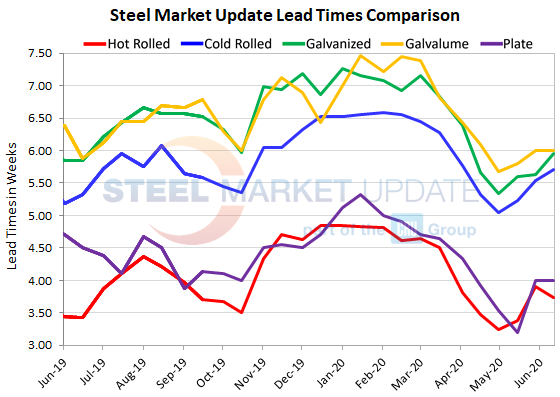SMU Data and Models

Steel Mill Lead Times: Continue to Extend as Mills Get Busier
Written by Tim Triplett
June 11, 2020
Lead times for spot orders of flat rolled and plate steels have extended in the past four weeks as demand has picked up and mill production has come down. In response to the COVID-19 shutdowns of nonessential businesses in March, steel producers idled furnaces to sync their output with demand. Lengthening lead times this week suggest the mills are busier than they were a month ago and that demand may be improving as government restrictions ease and more companies get back to work.
Hot rolled lead times now average 3.73 weeks, up from 3.38 in mid-May. Cold rolled orders currently have a lead time of 5.71 weeks, up from 5.23 a month ago. The current lead time for galvanized steel is 5.95 weeks, up from 5.60, while Galvalume is at 6.00 weeks, up from 5.80 in SMU’s check of the market four weeks ago.
Plate lead times have also extended over the past month to 4.00 weeks from 3.20.
A few mills have begun to bring idled capacity back online already in anticipation of rising demand. Steel Market Update will be watching lead times closely for signs that production additions are outpacing new orders.

Note: These lead times are based on the average from manufacturers and steel service centers who participated in this week’s SMU market trends analysis. Our lead times do not predict what any individual may get from any specific mill supplier. Look to your mill rep for actual lead times. Our lead times are meant only to identify trends and changes in the marketplace. To see an interactive history of our Steel Mill Lead Times data, visit our website here.

Tim Triplett
Read more from Tim TriplettLatest in SMU Data and Models

SMU Scrap Survey: Sentiment Indices rise
Both current and future scrap sentiment jumped this month, though survey participants reported responses before key trade news was announced.

SMU Survey: Sentiment splits, buyers have better view of future than the present
SMU’s Steel Buyers’ Sentiment Indices moved in opposite directions this week. After rebounding from a near five-year low in late June, Current Sentiment slipped again. At the same time, Future Sentiment climbed to a four-month high. Both indices continue to show optimism among buyers about their company’s chances for success, but suggest there is less confidence in that optimism than earlier in the year.

SMU scrap market survey results now available
SMU’s ferrous scrap market survey results are now available on our website to all premium members. After logging in at steelmarketupdate.com, visit the pricing and analysis tab and look under the “survey results” section for “ferrous scrap survey” results. Past scrap survey results are also available under that selection. If you need help accessing the survey results […]

SMU flat-rolled market survey results now available
SMU’s latest steel buyers market survey results are now available on our website to all premium members. After logging in at steelmarketupdate.com, visit the pricing and analysis tab and look under the “survey results” section for “latest survey results.” Past survey results are also available under that selection. If you need help accessing the survey results, or if […]

SMU Survey: Sheet lead times stabilize, plate contracts
Mill lead times for sheet products were steady to slightly longer this week compared to our late June market check, while plate lead times contracted, according to steel buyers responding to this week’s market survey.
